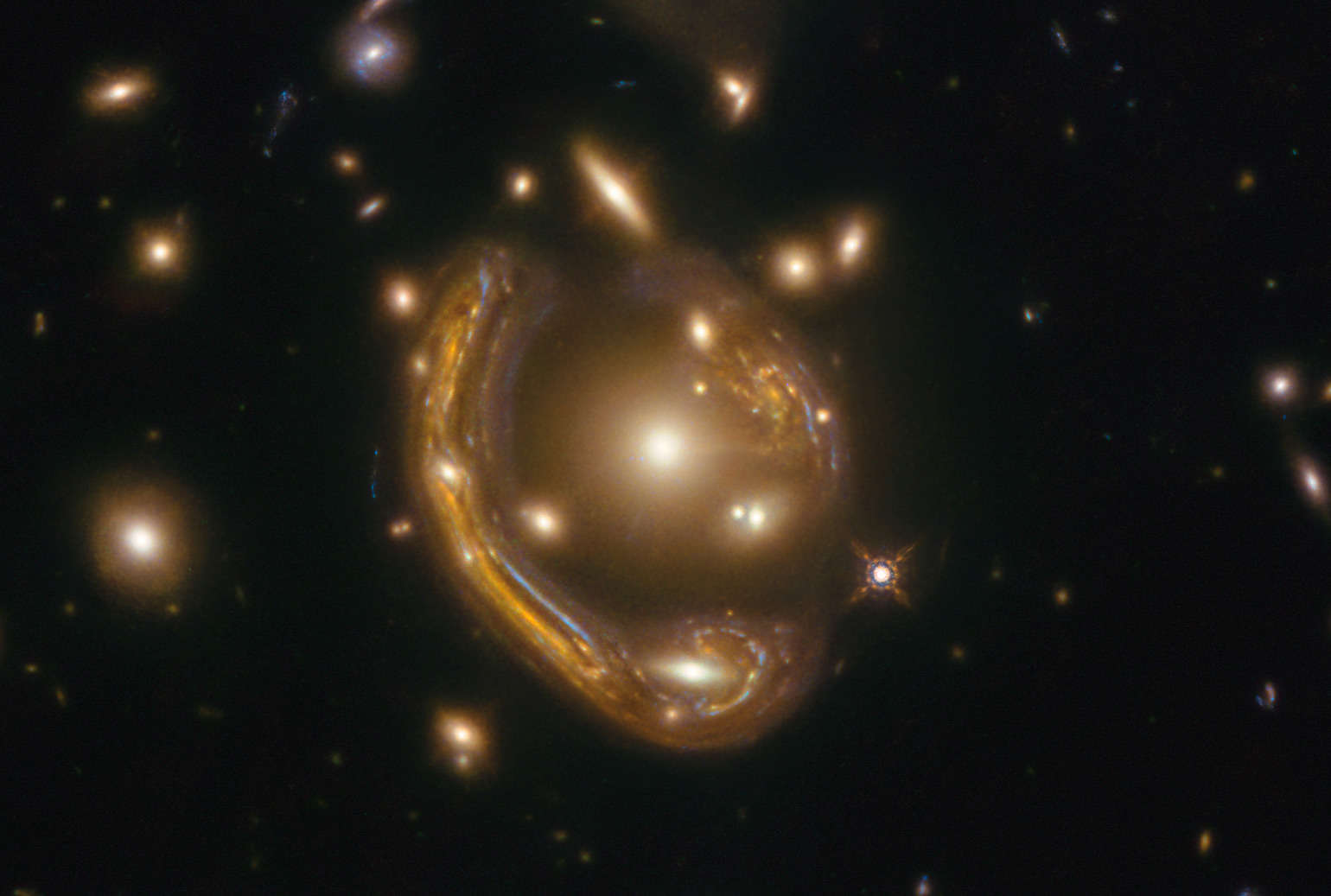Create a free profile to get unlimited access to exclusive videos, sweepstakes, and more!
The Molten Ring Galaxy is blasting out a trillion suns worth of infrared radiation

A galaxy billion of light years from Earth is pouring out vast amounts of infrared light, the tell-tale signature of furious star birth.
That’s already pretty cool, but it gets better: As the light from this galaxy traverses the Universe it passes by a massive galaxy cluster that distorts it, amplifying its brightness, cloning it repeatedly, and twisting it into what looks like a river of molten gold.
I mean, seriously. Look at this.
Whoa.
That gorgeous twisted weirdness is called WISE J022057.56- 383311.4 — it was first seen in images by the Wide-field Infrared Survey Satellite, and the numbers are its coordinates on the sky; let’s call it J0220 for short — and it was singled out for study because the astronomers are interested in a population of galaxies called Submillimeter (Bright) Galaxies, or SMGs. These galaxies are bright at wavelengths between infrared and radio (submillimeter light has a wavelength less than a millimeter) because they’re making lots and lots of stars. When stars die they generate dust, grains of carbon and silica, which when warmed by other stars glow at submillimeter wavelengths (if this sounds familiar, it may be because we know dying stars like Betelgeuse make a lot of dust and is likely the reason that star dimmed so much recently).
These galaxies were most common when the Universe was roughly 2–4 billion years old. The Universe is now 13.8 billion years old, so it took the light from these galaxies around 10–12 billion years to get here. In other words, we see them nearly clear across the observable Universe.
J0220 had characteristics that looked like an SMG, so the astronomers studying it followed up with the APEX telescope to confirm it, and used previously observed archived data to measure the distance to this galaxy of over 9 billion light years. The Hubble images were taken by a different astronomer in 2015, and used to help analysis.
The image is not natural color; what’s displayed as blue uses a green filter, green is a combination of green and red, and what you see as red is from an infrared filter. The combination produces that lovely golden hue.
So that’s the color. What about that shape?
Coincidentally, there’s a massive cluster of galaxies called GAL-CLUS-022058 about 4 billion light years fro us, and it’s situated almost exactly in between us and J0220. The cluster is immense, with hundreds of galaxies totaling a mass 100 trillion times the Sun’s. That’s a lot of gravity, which distorts spacetime pretty severely around the cluster. The more distant galaxy’s light passed through that warp, getting twisted into arc, multiplied into four separate images, and brightened on average by a factor of 18. This effect is called gravitational lensing, and you can read all about how it works in a previous article.
That’s actually helpful! Because it’s brightened by the lensing it’s easier to study the galaxy despite the distortion. Even with it you can see that it’s a spiral galaxy, and has blue arms indicating active star formation (massive stars are bluer and luminous, so these short-lived stars dominate the visible-light colors when a galaxy makes lots of stars).
Combining all the observations, the astronomers find that J0220 is blasting out infrared light from all the warm dust in it to the tune of a trillion times the energy of the Sun. The galaxy itself probably only has half the number of stars in it our Milky Way galaxy does, but has so much dust converting that light into infrared that it glows fiercely at those wavelengths.
Using that number to calculate the star formation rate indicates that J0220 is birthing stars at about 70–170 times the mass of the Sun per year. That’s a lot; the Milky Way produces only about 2 — yes, two — times the Sun’s mass worth of stars per year. I’ll note that rate is an average. It’s not like 70–170 new stars pop out of J0220 every year! First, stars take a long time to form, so there’s no one moment when a is born. Also, the rate is given in terms of mass, but most stars have less mass than the Sun (red dwarfs, the most common stars, have 0.1 to 0.5 times the Sun’s mass, more or less). The math gets a bit complicated, but in reality one solar mass means maybe 10 stars are actually formed. So 70–170 solar masses per year translates into, say, 700–1,700 million stars per million years.
However you look at it, it’s a lot of stars! 50 or more times the rate at which they’re born in our own galaxy. J0220 is getting busy.
Star formation in the Universe isn’t a constant. It took a few billion years for galaxies to get their acts together and really start cranking them out; the period from roughly 2–4 billion years after the Big Bang is called “Cosmic Noon” because that’s when star formation peaked. In general cosmically it’s been declining ever since.
Stars born at that time are like Baby Boomers now; getting older but still dominating things, so they’re a key demographic in stellar population and we need to understand them to understand how galaxies behave. And that means observing galaxies three-quarters of the way across the observable Universe to see what was going on as these stars were being born. J0220 appears to be one of the brighter of its class, made even brighter to us by a quirk of physics and a happenstance of position.
Sometimes luck plays a role in science, and in this case also produces surpassing beauty, a piece of natural art with the colors of a Klimt and the shape of a Dali. Together, the science and art make a portrait of the young cosmos.





























